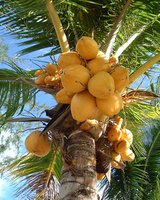The Coconut Juice Capitol : Davao Oriental, Philippines
Coconut juice and coconut nutrition from Davao Oriental
With The Philippine President bringing home the news of potential foreign investments in Philippines’ coconuts, the coconut haven in the South is again in an aggressive mood.
Producing the most number of coconuts nationwide with one billion nuts annually from its vast crop area of 156,837 hectares, Davao Oriental is now back to capture foreign markets as the world starts to value the health and economic benefits of coconut nutrition.
With more than 100,000 coconut farmers, in the province alone, to benefit from this global trend, Davao Oriental sees a new hope to what most have mistakenly thought of as a dead industry.

|
Though a bit young in maximizing the full potential of this product, investors whether local or foreign are starting to eye the wealth of this province. There are now geo-textile producers, virgin coco oil producers, coco lumber dealers, fresh coco traders, and food processors maintaining their investments.
Davao Oriental has not just confined its capacity as exporter of crude oil and copra pellets, rather the province made use of technology and started producing virgin coco oil, coco coir, peat, and other items made from coconut.
The world thirsts for coconut juice
The vastness of the coconut's potential continuously proves boundless for even now, another use of coconut has gained the interest of the world market making use of coconut juice as a coconut drink.
With this trend, Department of Trade and Industry Davao Oriental office shared that some businessmen have started inquiring for suppliers of coconut water.
At the moment, there is already an existing Chinese investor that gets coconut juice and coconut meat supplies from the province and exports it abroad.
“The good news for our farmers is that the demand is not just for coconut water from young coconut but they even look for those from matured coconut,” she said.
Philippine Coconut Authority Region XI director Lornito Orillaneda said the region has so much matured coconut juice which is usually wasted. “Instead of throwing it away, we are now teaching the farmers on how to process this coconut water,” he said
Thirty percent of the coconut content is water, thus, PCA constantly tells the farmers to make use of this part of the coconut.
Buko juice is the coconut water sourced from a young coconut. However, the bulk of the coconut supply is matured coconut. This gave hope to coconut farmers as they could now also make money out of the matured nuts.
PCA shares that a simple process of pasteurization is required to remove the oily portion of the matured coconut water and make it just like the popular “buko juice” or the coconut juice from the young nut.
Studies have shown that coconut juice is actually more nutritious than whole milk because it has less fat and doesn’t contain cholesterol. Coconut nutrition is also better than processed baby milk since it contains Lauric Acid which is present in mother’s milk. It contains natural sugar, salt, and vitamins.
Coco Coir as another by-product of coconut
Another useful part of a coconut is its coco fiber made into geonet or coco coir. It is known to be a good material to prevent soil erosion and enhance slope stabilization.
The DTI announced that additional investments on the coco coir industry in Davao Oriental was noted following the launching of the coco coir industry.
The technical working group formalized from its launching has focused financial assistance to seven regions identified to be coco-producing areas. This includes Davao Oriental targeted to benefit from this assistance.
Ambi divulged many coco coir companies in the province have expanded operations as the demand increases and the local production consistently falls short. This signals a brighter business potential for the province in selling Davao Oriental’s coconut product.
The coco coir industry in the province now focuses production for its local market as the Department of Public Works and Highways posted a huge demand for coco peat or coir and coconut fiber materials for soil conditioning and erosion control for infrastructure projects.
There are a hundred more ways to maximize the use of coconut. Scientists and inventors continue to explore the power that this “tree of life” brings. As long as there is that bearing tree, the province of Davao Oriental – the land of coconut, will continue to make a mark in both export and domestic markets.(PIA/Mai Gevera-Macapagat)


